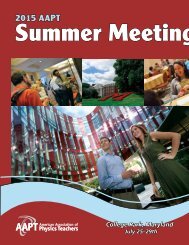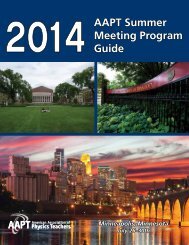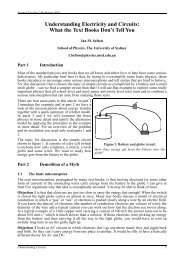final-program-12-23-14-3
final-program-12-23-14-3
final-program-12-23-14-3
You also want an ePaper? Increase the reach of your titles
YUMPU automatically turns print PDFs into web optimized ePapers that Google loves.
Tuesday morning<br />
GF09: 9:50-10 a.m. New HTML5 Interactive Physics<br />
Simulations from cK-<strong>12</strong> Foundation<br />
Contributed - Byron J. Philhour, cK-<strong>12</strong> Foundation / San Francisco<br />
University High School, 860 41st Ave., San Francisco, CA 94<strong>12</strong>1; byron.<br />
philhour@ck<strong>12</strong>.org<br />
Miral Shah, Neeru Khosla, cK-<strong>12</strong> Foundation<br />
In collaboration with physics teachers, animators, and software developers,<br />
the nonprofit cK-<strong>12</strong> Foundation has generated dozens of new<br />
free-to-use tablet and laptop-ready HTML5-based interactive physics<br />
simulations. Our goal for each sim is to build a bridge between compelling<br />
real-world situations and the more abstract and mathematical<br />
physics descriptions. These sims are appropriate for middle school,<br />
high school, and introductory college-level physics. Topical coverage<br />
is broad, from motion and mechanics to electricity & magnetism,<br />
sound and light, and modern physics. Our physics sims are based in<br />
engaging, real-world examples, big questions, a playful interactive<br />
sandbox, graphs of data, and diverse modes of instructional feedback.<br />
This presentation is one part of our efforts to engage in a discussion<br />
with the physics education community about how best this work can<br />
be used to facilitate both classroom-based and independent instruction,<br />
foster interest in science, challenge misconceptions, and support<br />
best practices in online learning.<br />
GF10: 10-10:10 a.m. Doceri in and Out of the Physics<br />
Classroom<br />
Contributed – Michael R. Gallis, Penn State Schuylkill, 200 University<br />
Dr., Orwigsburg, PA 17961; mrg3@psu.edu<br />
Doceri (https://doceri.com/) is branded as “an Interactive Whiteboard<br />
for iPad” and allows users to control, annotate, and record<br />
presentations on a presentation workstation using wireless internet<br />
connections. The Doceri software provides inexpensive smartboard<br />
functionality with great flexibility. This presentation discusses our<br />
experience using Doceri for small introductory physics classes. In<br />
addition to standard smartboard functions, we’ll discuss “in seat’<br />
student board work and out of class videos for additional examples<br />
and lecture snippets.<br />
Session GG: Development of Perception<br />
of Extraterrestrial Life II<br />
GG01:<br />
Location: Executive 2A/2B<br />
Date: Tuesday, January 6<br />
Time: 8:30–9:10 a.m.<br />
Presider: Julia Olsen<br />
8:30-8:40 a.m. The Drake Equation and the Historical<br />
Extraterrestrial Life Debate<br />
Contributed – Todd K. Timberlake, Berry College, 2277 Martha Berry<br />
Hwy., NW, Mount Berry, GA 30<strong>14</strong>9-5004; ttimberlake@berry.edu<br />
The Drake Equation was formulated in 1961 by radio astronomer<br />
Frank Drake as a tool for estimating the number of communicating<br />
civilizations in the Milky Way galaxy. The equation is still a centerpiece<br />
of discussion about extraterrestrial intelligence. However, ideas<br />
about extraterrestrial life have their origins long before 1961. I will<br />
report on how I have used the Drake Equation as a teaching tool in<br />
a course on the extraterrestrial life debate. The Drake Equation (or a<br />
modified version) can be applied to this historical debate, from the<br />
Ancient Greeks to today, and the changing values of the parameters<br />
in the equation provide a convenient way to see how views about<br />
extraterrestrial life have evolved throughout history.<br />
GG02:<br />
8:40-8:50 a.m. Exploring the Scales of the Universe to<br />
Understand Fermi’s Paradox<br />
Contributed – Richard Gelderman, Western Kentucky University, 1906<br />
College Heights Blvd., Bowling Green, KY 42101-1077; gelderman@<br />
wku.edu<br />
Of all the themes in science fiction, one of the most consistently<br />
popular is the First Contact between humans and extraterrestrial life<br />
forms. Yet we Earth creatures live with the reality of being the only<br />
example of life known to us. This presentation describes how we utilize<br />
“Fermi’s Paradox” (Where is everybody) as a chance to motivate<br />
students to learn about the vastness of space and time in our universe.<br />
Given a chance to understand the vastness of our Milky Way galaxy<br />
and the difficulties with near light-speed travel, students will tend to<br />
conclude that the absence of Federation starships is an expected outcome<br />
of how aptly “space” has been named. Then, however, students<br />
get exposed to how old is our cosmos and synthesize all the information<br />
together to understand that other, more nuanced, arguments are<br />
required if aliens exist in a non-”Men in Black” reality.<br />
GG03:<br />
8:50-9 a.m. Aliens in the Classroom: Astrobiology as an<br />
Introduction to Science<br />
Contributed – Barbra K. Maher, Red Rocks Community College, 13300<br />
W. Sixth Ave., Lakewood, CO 80228; barbra.maher@rrcc.edu<br />
A recent community college student survey showed an overwhelming<br />
majority believe in extraterrestrial life. Red Rocks Community College<br />
has introduced the subject of extraterrestrial life into several of<br />
our existing physics and astronomy courses through activities, papers<br />
and debates. However, such a high interest topic warranted more<br />
coverage in the curriculum. After a year in development, in 2013,<br />
AST 150:Astrobiology was approved as a guaranteed transfer science<br />
course for the Colorado community college system. The course is<br />
designed as an introductory level lecture class, with no pre-requisites.<br />
AST 150 develops foundational knowledge in astronomy, biology,<br />
geology and physics. Astrobiology is an excellent, interdisciplinary<br />
introduction to the process of scientific exploration and inquiry. It<br />
directly requires that students use critical thinking skills to analyze<br />
current theories and develop ideas through activities, presentations,<br />
discussions and article reviews, on topics such as extremeophiles,<br />
Jovian moons, planet terraforming, exoplanets and UFO sightings.<br />
GG04:<br />
9-9:10 a.m. Advanced Civilizations Below the Dyson Net<br />
Level: Terraformed Goldilocks Planets<br />
Contributed – Ronald C. Metzner, Lathrop High School, 5001 Haystack<br />
Dr., Fairbanks, AK 997<strong>12</strong>; ronald.metzner@k<strong>12</strong>northstar.org<br />
Freeman Dyson proposed that an advanced civilization could<br />
disassemble a planet the size of Jupiter and create a net of matter to<br />
surround the parent star to utilize all of the star’s energy for power.<br />
Only waste heat would escape. He proposed that we should look for<br />
these infrared signatures as evidence of an advanced civilization. An<br />
easier way for a civilization with nuclear power and local space travel<br />
to create “living space” would be to “transform” the planets in their<br />
“Goldilocks” temperature zone into habitats that support life. The<br />
signature of life on our home world is free oxygen in the atmosphere.<br />
Our next generation of space telescopes will be capable of finding<br />
oxygen in planetary atmospheres. Find one star with all its Goldilock’s<br />
planets showing oxygen and you may have found an advanced<br />
civilization. Find a cluster of stars like that and you have found “The<br />
Federation of Planets.”<br />
90<br />
JANUARY 3-6<br />
2015<br />
WINTER MEETING SAN DIEGO, CA






